When I first dipped my toes into online course creation, I had no idea what I was getting myself into. It took me almost a year to put together my first course and I sold it to a grand total of three people on launch day. It was a categorical flop. But things picked up.
Fast forward five years, and I’ve helped hundreds of people sharpen their skills through my online training courses. I’ve built courses that teach freelancers how to pitch, courses about creating amazing content, and courses to help market businesses. Over 500 students have sat through the modules I meticulously created, earning me an extra $10,000 a year on top of my freelance income.
So, if you’re ready to dip your toes into online course creation, this guide is for you. Whether you’re a seasoned expert or just starting out, this guide will walk you through the ins and outs of selling training courses online.
The Difference Between a Training Course and Other Online Courses
While training courses and regular online courses are similar, training courses have a unique focus. They’re designed to teach specific skills or knowledge for a trade or activity. Unlike a mindfulness course that might help you relax, a training course equips you with practical, often job-related skills.
For example, when I created my signature course, Pitch & Prosper, my aim wasn’t just to share information that anyone could find online. I wanted to provide hands-on training that students could immediately apply to their work. This distinction is crucial because it shapes how you create and market your course.
Here are some comparisons to highlight this distinction:
- A 6-week yoga flow course versus a training course that shows you how to write a resume.
- A curry cooking course versus a two-week training course that shows you how to groom a short-haired dog.
You see the difference?
Is it Worth Selling Training Courses Online?
Absolutely! But it’s only worth it if you have something specific to teach (and don’t worry, most people have a training course in them).
There are two avenues you can go down with training courses:
- B2B: teaching specific skills to businesses or in a business environment.
- B2C: teaching knowledge to everyday consumers.
Let’s break this down.
Selling B2B training courses
The kind of courses I create are technically in the B2B sector. I sell courses to other businesses, even if those businesses are made up of just one person. You can go much bigger with B2B and target entire organizations—but bear in mind this is a whole different ball game. You’re dealing with high-flying clients who are often buying for the whole company.
This means you need to:
- Craft detailed proposals that speak to the value participants will get.
- Create package offerings that hit a few different pricing tiers.
- Tailor content to specific company needs.
It’s more time-intensive, but the payoff can be huge. B2B training courses can easily net you six-figure deals with big companies. But you’ve got to know your stuff to stand a chance.
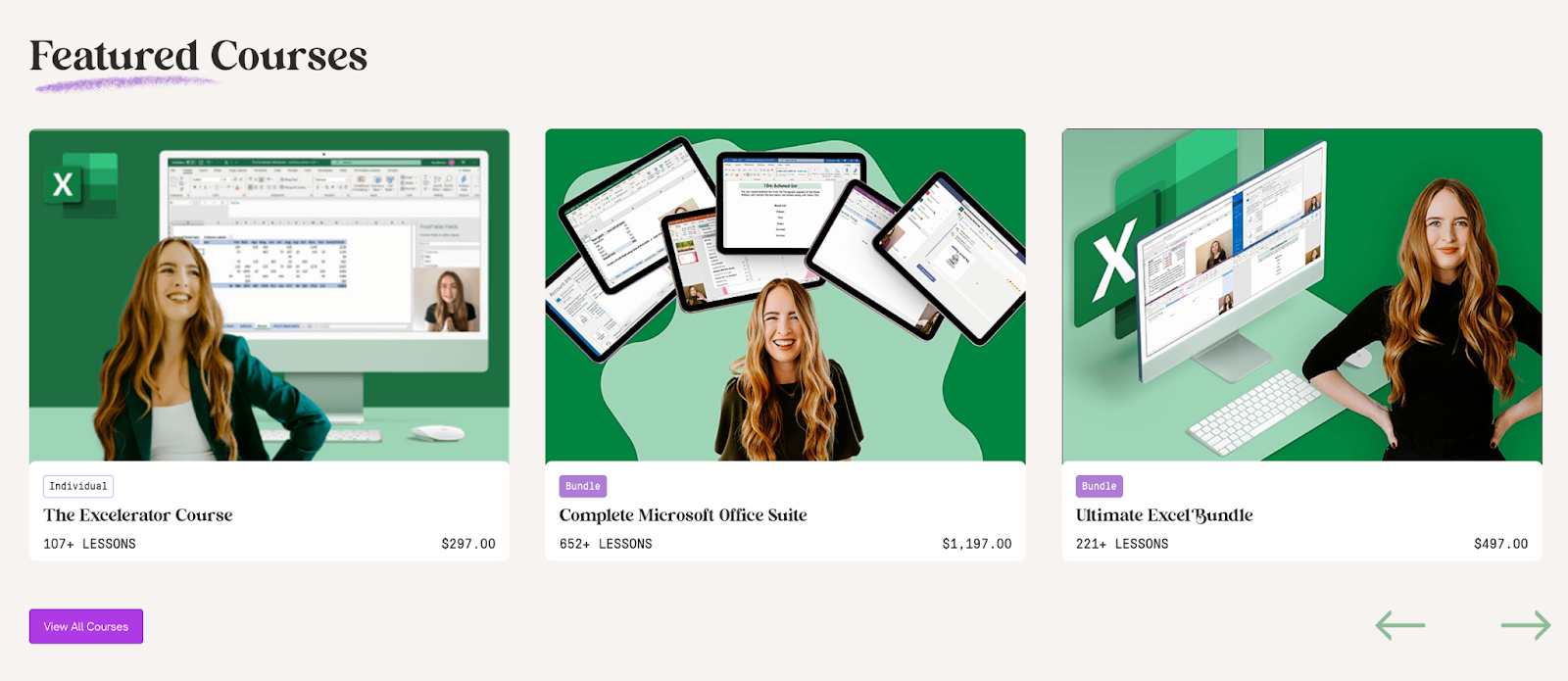
Selling B2C training courses
On the flip side, B2C offers a far more relaxed, less corporate approach to selling courses. These are trainings that teach everyday consumers something, like crocheting, pilates, or how to improve their communication skills.
Unlike B2B courses, B2C courses are easier to scale because:
- You can sell them to anyone, anywhere
- They’re far more passive and less hands-on
- They have a global reach
The beauty of B2C is that once you’ve created the course, it can continue generating income with additional effort.
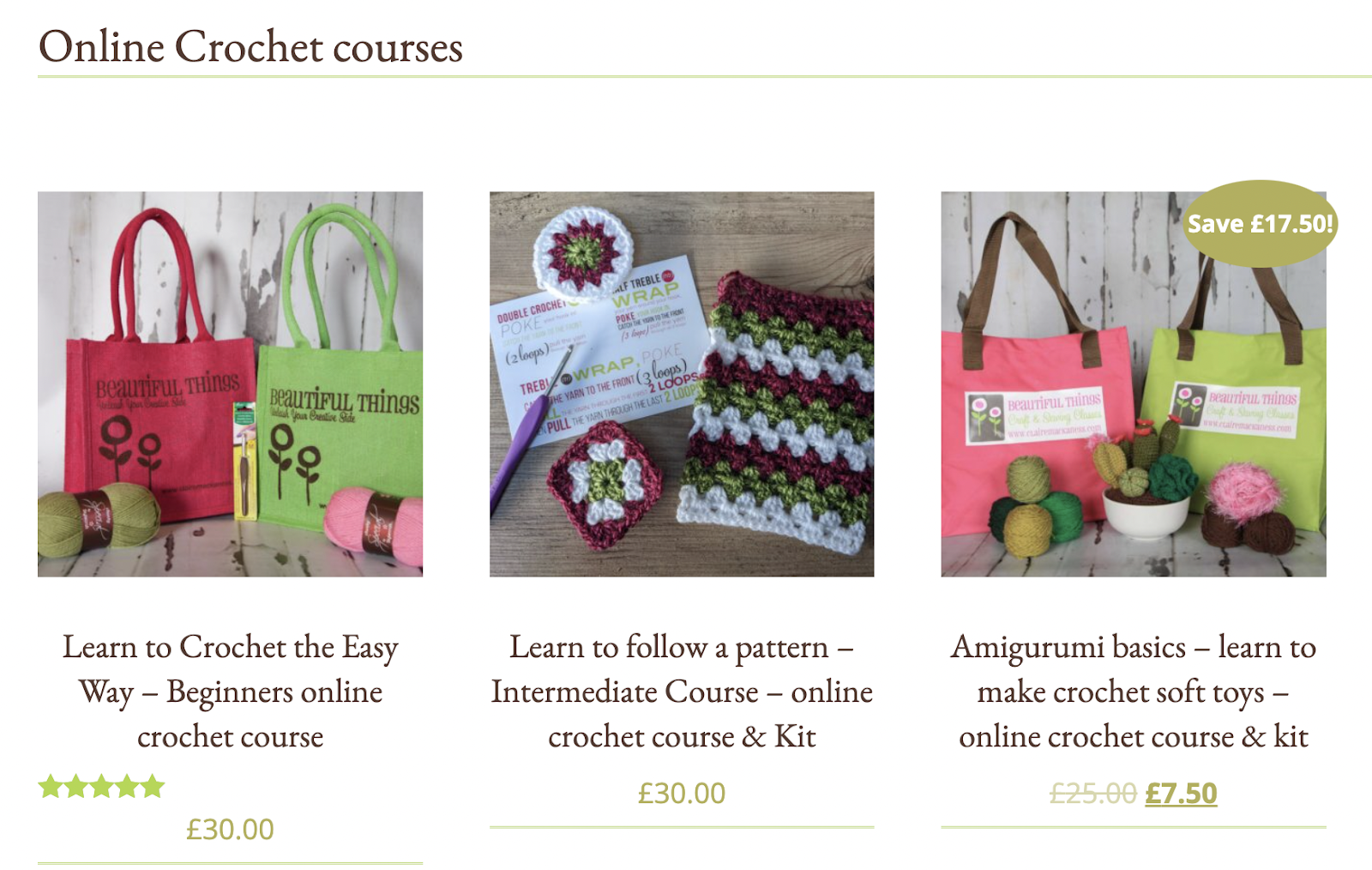
How to Sell Training Courses Online: A Step-by-Step Process
1. Choose your course topic
The easiest way to choose a course topic is to combine your skillset with a skill gap in your industry. For me, it was noticing that many freelancers struggled to find the right brands to pitch. I’d had great success with it over the years, so it made sense to teach something I know well and something that people need.
Your niche should be specific enough to attract a dedicated audience but broad enough so enrollments don’t dry up.
Here are some questions to ask yourself:
- What am I good at?
- What do friends/family/colleagues often ask me for help with?
- What problems are people in my industry facing?
- What do people not know that will help them do X, Y, or Z (e.g. become less stressed, run Excel calculations, or create a better household budget)?
It’s important to choose a topic you know lots about, but that doesn’t mean you need to be the best at it. In fact, an important piece of advice I was given early on in my career is that you only need to be one or two steps ahead of the people you’re teaching. So, you might be relatively new to, say, pilates or vegan cooking, but as long as you’re one step ahead of the people you’re teaching, you’ll be fine.
It’s sometimes better to be closer in skillset to your students because the further removed you get, the harder it is to relate to their current issues and pain points.
2. Create your course content
Most online training courses are broken down into modules so information can be consumed in bite-sized chunks. The last thing you want to do is overwhelm your new students.
Creating your course involves more than just recording videos.
Here are some key steps to consider:
Develop your curriculum
Figure out what it is you’re going to teach and how you’re going to teach it. The easiest way to do this is to work backward. Identify the overall lesson or knowledge you want students to come away with and then plot a route to help them get there.
Think about what information they need to get to that end knowledge point and how you can deliver.
When creating Pitch & Prosper, I knew I wanted students to come away with a clear idea of who to pitch and how to pitch them. To do this, they need to know:
- What to include in a pitch
- How to find the right people to pitch
- How to follow up
These became core modules within the curriculum. If you can, break down the end lesson into smaller segments, where each of those segments becomes a module.
Develop engaging content
The type of content you create for your course will depend on what you’re teaching and how your audience prefers to consume content. For example, if you’re teaching advanced yoga poses, videos are a better option than text-based lessons.
While videos are the obvious content format to create for courses, consider other interactive ways to engage students too:
- Quizzes: put students’ knowledge to the test with little pop quizzes at the end of each module.
- Exercises: help students put what they’ve learned into action with simple exercises.
- Workbooks: help students retain knowledge with workbooks they can jot relevant notes in.
Make the process easier by using tools to help you. Use design tools like Canva to create workbooks and record videos with software like Loom.
💡 Pro tip: always include real-world examples. In my courses, I use actual pitching scenarios to illustrate concepts. This gives students the context behind what you’re teaching and shows them what it looks like in action.
3. Choose the Right Platform to Host Your Course
The ideal course hosting platform aligns with your needs. Consider factors like how easy it is to use, what customization options are available, and how it processes payments.
I’ll dive deeper into platform options later, but look for solutions that:
- Let you upload different content formats.
- Segment your course into easy-to-follow modules.
- Allow you to brand the backend and create a front-end landing page.
- Take payments from students wherever they are in the world.
4. Build Out Your Sales Funnel
This is where many course creators stumble: selling the course. It’s easy enough putting together a curriculum that shares your knowledge, but getting people to actually invest in the course? That’s another story entirely.
I’ve found that people rarely buy my courses the first time they come across them. They need to know and trust me before they’re willing to part with their cash. This is why a sales funnel is so important. It attracts the right kind of person and shares key information that should gently push them to buy your course.
How to build out your sales funnel:
Promote your course on various platforms
Start by casting your net wide to get people into your funnel. Use social media to connect with potential students, share informative content relevant to your course, and foster personal connections with your audience.
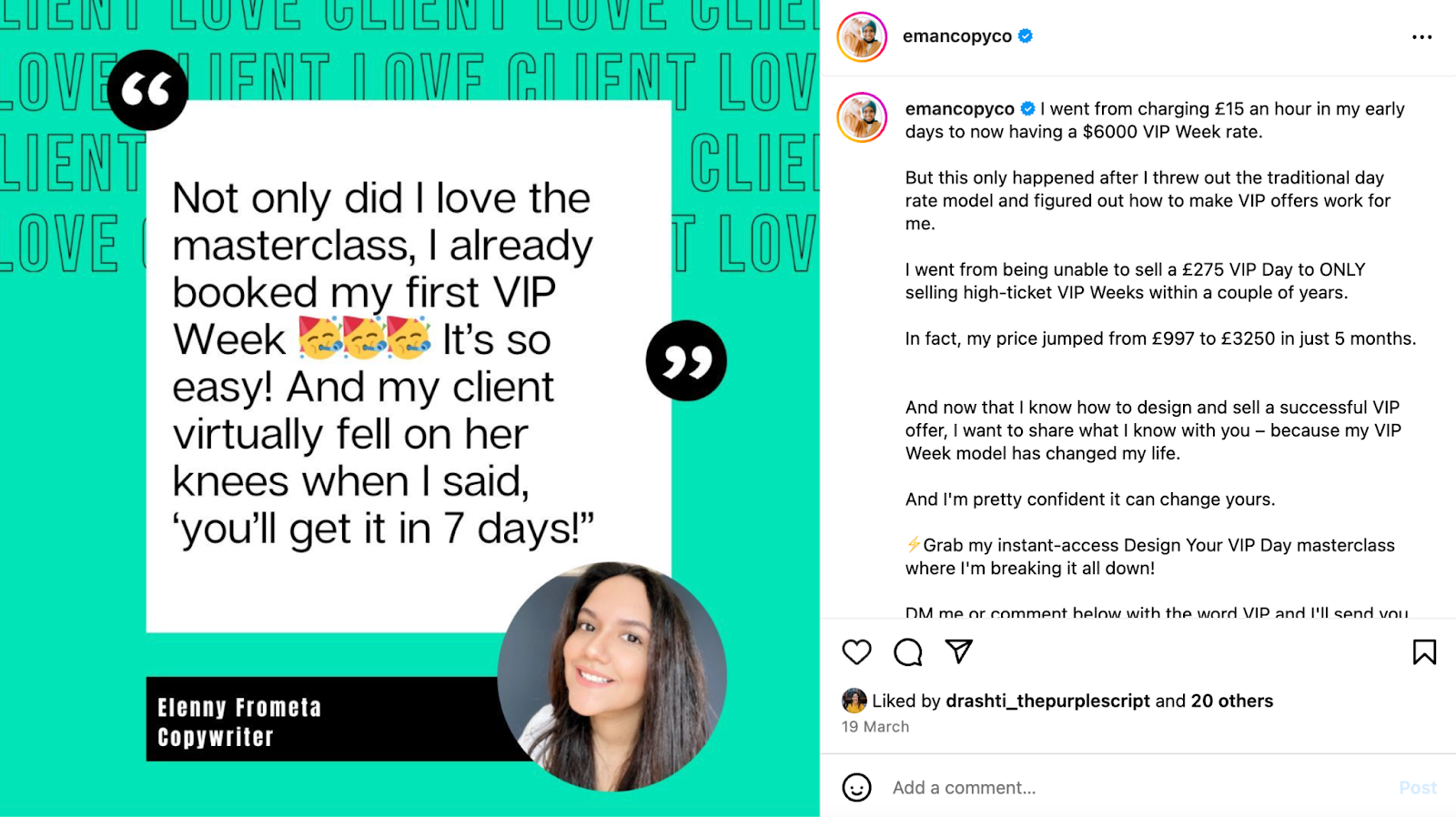
Attract potential students with a freebie
Instead of promoting your course straight away, give potential students the chance to get to know your teaching style with a freebie or a lead magnet. This is something that provides a quick win in exchange for an email address.
For example, to get people into my sales funnel, I offer three pitching-related lead magnets:
- A checklist for finding the right brands to pitch
- A guide to what content leads look for in a pitch
- A free training that goes through my pitching strategy

By promoting a freebie closely related to my course topic, I only get people actively interested in pitching into my sales funnel. I know these people want to get better at pitching and are, therefore, more likely to buy Pitch & Prosper.
Create an email sales sequence
Sales sequences slowly warm up potential students until they’re ready to invest in your course. Start by crafting a series of 5-7 emails that gradually build interest and urgency around your course.
Email sales sequences typically start with value-packed content related to the course topic, and then introduce the course as a solution to a specific problem.
Use the emails in the sequence to:
- Address common objections. What hesitations might someone have about investing in your course?
- Share success stories. What results have other students got or what can people expect to get out of your course?
- Highlight key benefits. What are the key takeaways from your course and what makes it different from others?
Each email should have a clear call-to-action (CTA) that pushes subscribers toward enrollment.
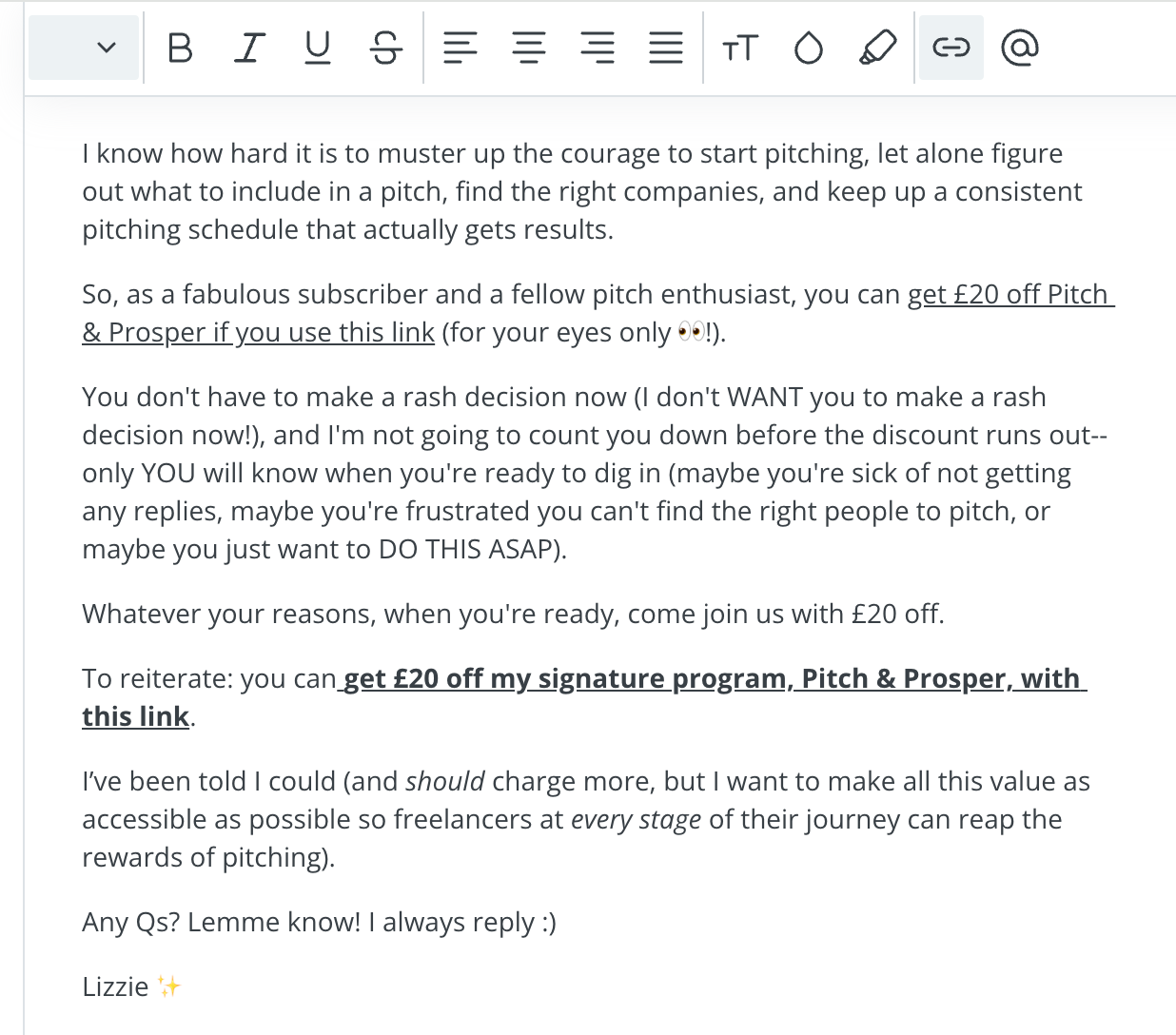
Offer discounts and limited-time deals
There are two ways you can “launch” your online course:
- Evergreen: it’s available for students to enroll all year round.
- Closed cart: it’s only available for enrollment for a short period of time.
I’ve tried both ways and the method you choose will depend on the format of your course and the content. For example, if your course is seasonal or has a live element to it, you probably want to stick to a closed cart format. But if students can work through the content at their own pace, you might decide to make it evergreen to secure sales throughout the year.
Whichever method you choose, I recommend implementing a few discounts and limited-time deals to sweeten the offering and encourage people who are on the fence to invest.
Here are some ways you can do this:
- Early-bird pricing. Reward students who sign up before a specific date and create a sense of urgency.
- Seasonal promotions. Try running deals for annual occasions, like back-to-school or the holidays. You can capitalize on times when people are more likely to invest in education.
- Scarcity tactics. Offer a set number of discounted spots or add a countdown timer to your emails that expire at a certain time.
- Bundle deals. Give students additional resources or courses at a reduced rate when they invest in your course. The additional resources should complement your course content and be highly relevant to student needs.
- Tiered pricing or payment plans. Make courses more accessible without directly discounting.
I’d warn against offering constant discounts as this can impact the perceived value of your course. Instead, focus on occasional, well-time offers.
What Happens Next? Keep Momentum High With These Activities
Once you've started selling courses, don't rest on your laurels. Keep up the momentum with new content, regular promotions, and community building.
Here are some activities you can do once you’ve launched your course.
- Build a community. Create a space for students to interact, like a forum or a social chat group. Whop has a great chat app where you can encourage discussions and get students to share their successes.
- Offer add-ons. Develop additional materials like workbooks, templates, and bonus modules that enhance the learning experience and continue to provide value to existing students.
- Create ebooks. Write and publish ebooks that relate to your course topics. These can serve as lead magnets or double up as additional resources to sell, which can expand your product line, grow your authority, and generate more sales.
- Host live Q&A sessions. Schedule regular live sessions where students can ask questions and get real-time feedback.
- Develop a coaching program. Offer one-on-one or group coaching as a premium service for students who want more personalized guidance. You can use this as a high-value upsell to your course offerings and grow your authority in your niche.
- Launch a podcast. Start a podcast where you discuss topics related to your course. This can be a great way to attract new students and provide ongoing value to existing cohorts.
- Create a membership site. Enjoy a recurring revenue stream with exclusive content, resources, and support delivered through a paid membership model. You can add a membership element to your Whop hub which collects recurring payments and provides a place to upload monthly content.
- Organize virtual events. Host online workshops, summits, or conferences to bring together experts in your field or provide bonus learning opportunities for your students.
- Gamify your course. Add points, badges, or leaderboards to your course to increase engagement and motivation.
- Develop a mobile app. Create companion apps for your courses so students can learn on-the-go and access course materials wherever they are.
- Collaborate with other creators. Partner up with complementary course creators to offer bundle deals or cross-promote each other’s products.
These additional activities not only increase engagement for students but can also provide extra revenue streams later down the line.
The 5 Best Places to Sell Training Courses Online
1. Whop
Most online course platforms require you to jump through hoops when setting up your course. This isn’t the case with Whop. With Whop, you can build out a whop hub with apps, each of which has its own unique features.
Think of apps like features that you can swap out, remove, and add to. The courses app is particularly popular because it allows creators to put together a comprehensive course in a matter of minutes (once you have the content). The course app makes it easy to add six types of lessons to your course:
- Multimedia lessons, including rich text, videos, and files.
- Text lessons.
- Video lessons.
- PDF files and workbooks.
- Knowledge checks that grade your students.
- Quizzes to test your students.
As well as these customizable course modules, Whop has a range of features made especially for course creators. These include landing pages, built-in payment processing, and tools for managing subscriptions and memberships.
To get started with Whop, sign in to your whop, create a profile, and start building your course with the app modules.
2. Udemy
Udemy is one of the more established marketplaces for online courses. You can tap into the large user base which can give your course visibility, but pricing is very competitive. Udemy takes a large chunk of your sales unless students come through your own promotions (and, in that case, you might as well host the course on a platform that lets you keep the lion’s share of your sales—like Whop).
3. Skillshare
Skillshare is similar to Udemy in that it’s a huge course marketplace, but it places particular emphasis on creative and professional skills. It uses a subscription model, where instructors are paid based on the watch time of their courses, so it isn't the best way to be making money. While this could be good for creators who product engaging, high-quality content, but may be less lucrative for niche topics.
4. Teachable
Teachable isn’t a marketplace—instead, it lets creators host and sell their courses independently. You get more control over branding and pricing, but it requires more marketing effort because you don’t get access to a pre-existing user base like you do with Udemy or Skillshare.
5. Thinkific
Thinkific is similar to Teachable. It lets creators build and host their own course websites and has useful features like custom domains, integrated email marketing, and advanced course design options. It’s particularly good for creators who have big plans for a comprehensive online school with multiple courses.
Sell Your Training Courses With Whop
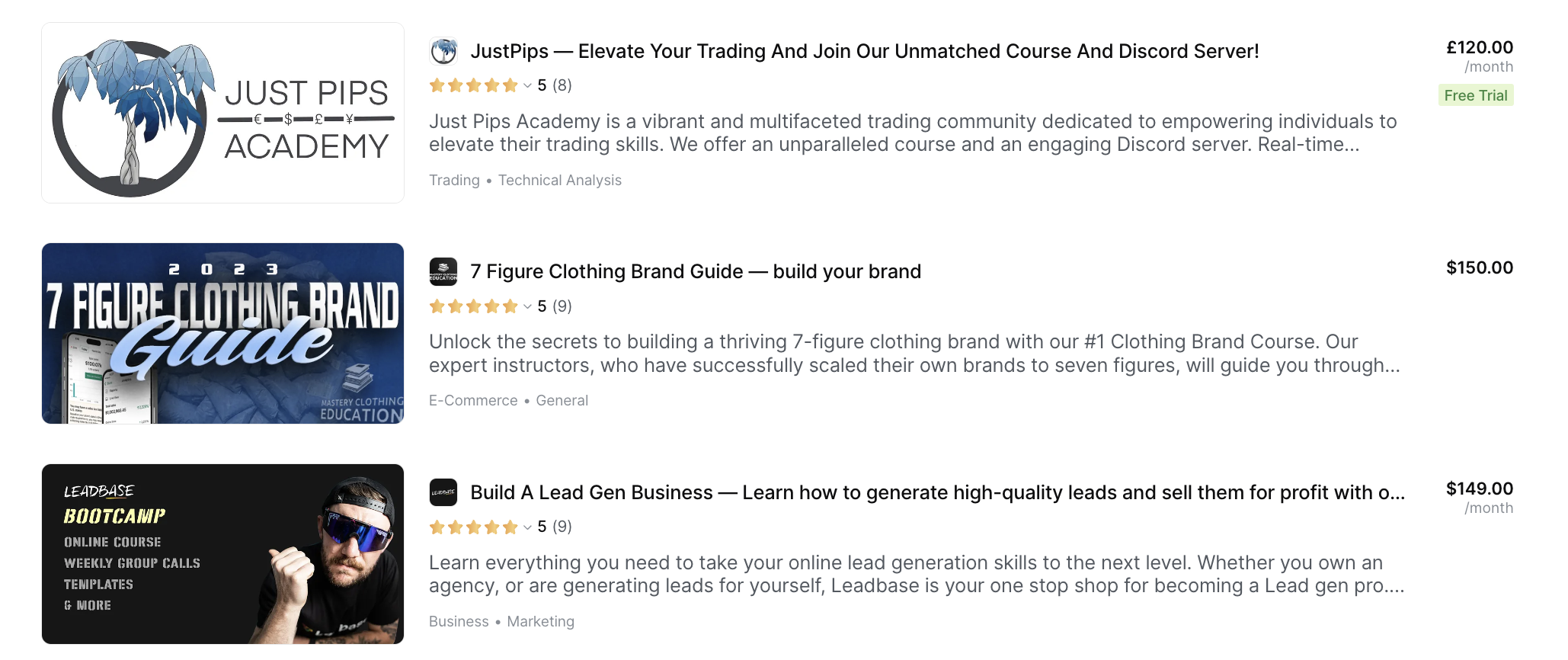
Remember, selling online courses is a marathon, not a sprint. Stay patient, keep refining your content, and always prioritize your students' success.
Choosing a course creation platform that makes the process easy and allows you to add extras to your course over time is a game-changer, which is why Whop is the perfect choice. Its innovative features and creator-friendly policies make it stand out in a crowded market. Whether you're just starting or looking to expand your reach, Whop provides the tools you need to succeed.
The innovative whop hub model means you can customize your course until your heart’s content, and unlike many other course platforms, Whop doesn’t charge a monthly fee. You just pay a 3% commission on each sale you make.
The best part is, that you don’t need fancy technical skills to start selling courses on Whop. The platform handles all the backend stuff—including enrollment and payment processing—so you can focus on growing your student base and creating amazing educational content.
Ready to turn your expertise into a thriving online training business? Start building your course on Whop today.





